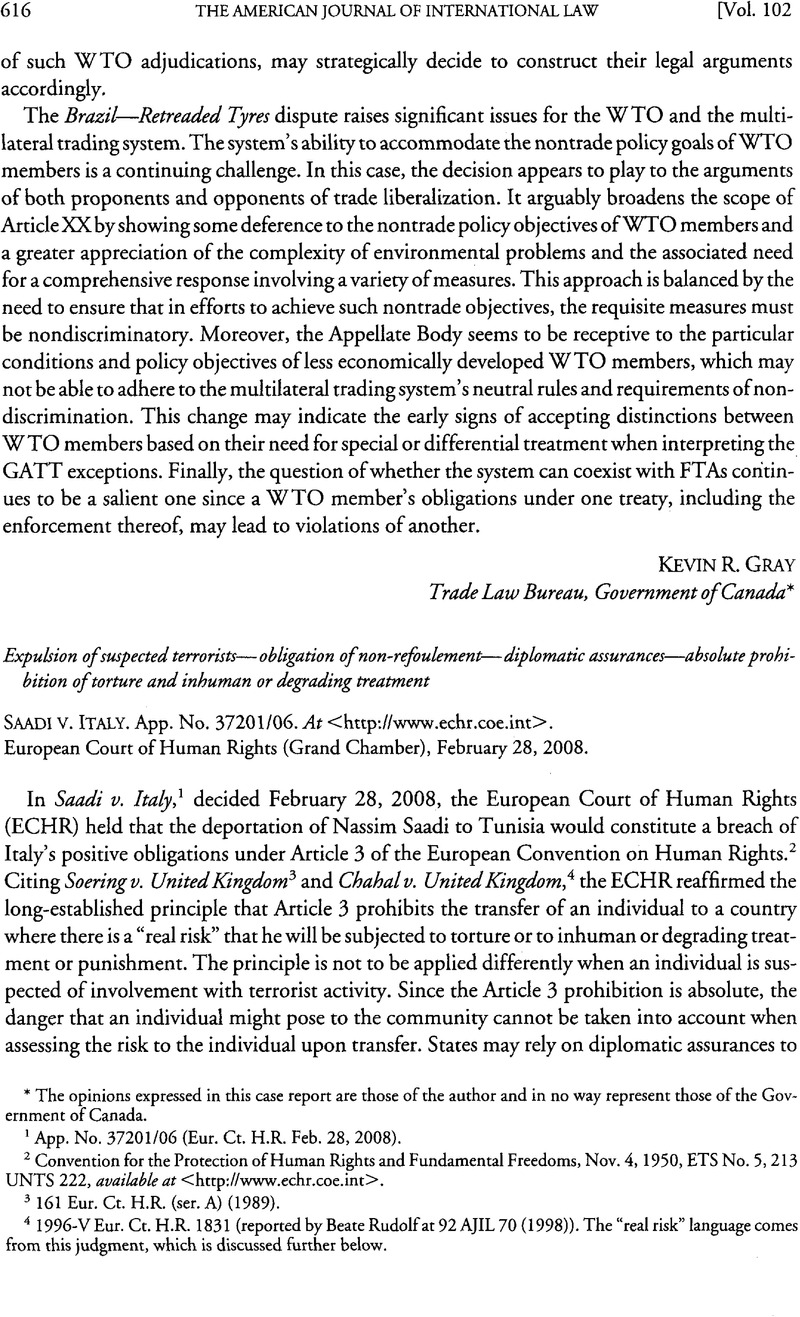Article contents
Saadi v. Italy
Published online by Cambridge University Press: 27 February 2017
Abstract

- Type
- International Decisions
- Information
- Copyright
- Copyright © American Society of International Law 2008
References
1 App. No. 37201/06 (Eur. Ct. H.R. Feb. 28, 2008).
2 Convention for the Protection of Human Rights and Fundamental Freedoms, Nov. 4, 1950, ETS No. 5, 213 UNTS 222, available at <http://www.echr.coe.int>.
3 161 Eur. Ct. H.R. (ser. A) (1989).
4 1996-VEur. Ct.H.R. 1831 (reported by Beate Rudolf at 92 AJIL 70 (1998)). The “real risk” language comes from this judgment, which is discussed further below.
5 A full recital of the factual background, including Saadi’s exhaustion of domestic remedies, is provided in paragraphs 9 to 57 of the judgment.
6 Article 36 of the European Convention provides that the ECHR may permit member states to intervene when one of its nationals is an applicant (Article 36(1)) or when it would be in the interest of the proper administration of justice (Article 36(2)). Any time after giving the respondent state notice of an application, the ECHR may give a third party permission to submit written comments or, in exceptional cases, to take part in hearings (Article 36(2), Rule 44(2)). In Saadi the United Kingdom intervened under Article 36(2) and Rule 44(2).
7 Chahal, para. 80 (citations omitted).
8 Convention Relating to the Status of Refugees, July 28, 1951, 189 UNTS 150.
9 See, e.g., Soering; Chahal.
10 See UN Committee Against Torture, Consideration of the Fourth Periodic Report of Italy, UN Doc. CAT/C/SR.721 (May 11, 2007).
11 [Prime Minister] Tony Blair, Press Conference (Aug. 5, 2005), at <http://www.number-10.gov.uk/output/Page804l.asp>.
12 [2008] EWCA Civ 289.
13 Id., paras. 68–82.
14 128 S.Ct. 2207 (June 12, 2008).
15 128 S.Ct. at 2225.
16 [2008] EWCA Civ 289.
17 128 S.Ct. at 2226. See also the concurring opinion of Justice Souter, joined by Justices Ginsburg and Breyer.
18 R (Al-Skeini) v. Sec’y of State for Defence, [2007] UKHL 26 (see case report in this issue by Ralph Wilde). Although R (Al-Jeddah) (FC) v. Secretary of State for Defence, [2007] UKHL58 (reported by Alexander Orakhelashvili at 102 AJIL 000 (2008)), provides that action otherwise prohibited by the European Convention may be permissible if undertaken pursuant to a Security Council resolution and limited to the extent required, it seems unlikely that this decision has the potential to undermine Saadi, given thejus cogens nature of the prohibition on torture and the absolute nature of Article 3. Decisions of the European Court of First Instance tend to support this analysis—see, for example, Ayadi v. Council, [2006] ECR 11-2139—although a decision by the European Court of Justice is awaited.
- 2
- Cited by




